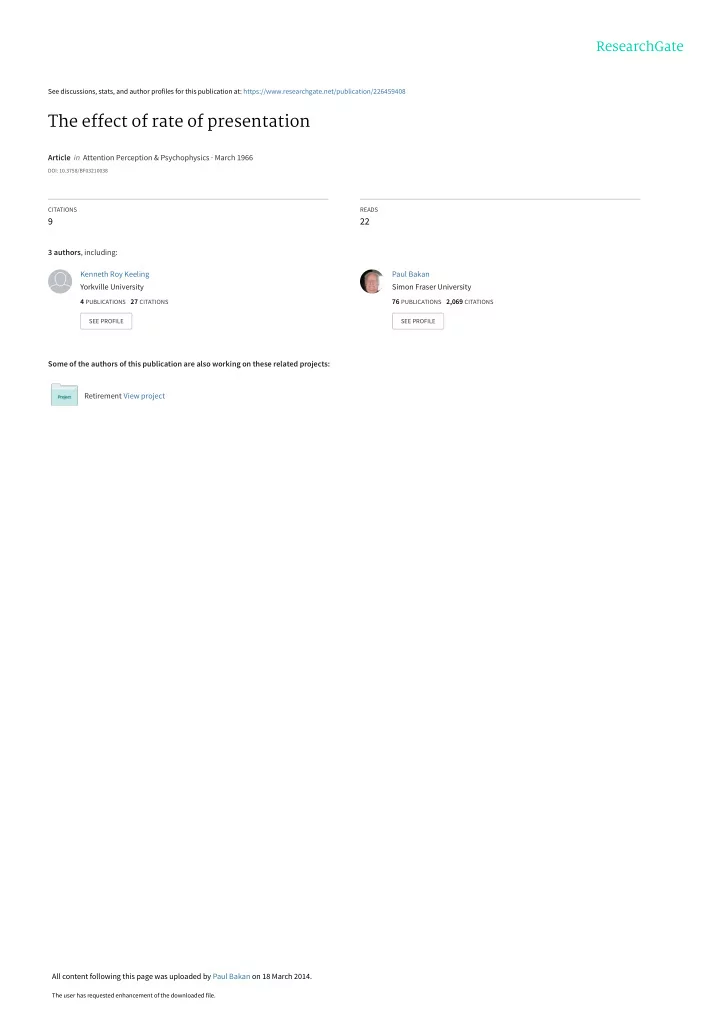

See discussions, stats, and author profiles for this publication at: https://www.researchgate.net/publication/226459408 The effect of rate of presentation Article in Attention Perception & Psychophysics · March 1966 DOI: 10.3758/BF03210038 CITATIONS READS 9 22 3 authors , including: Kenneth Roy Keeling Paul Bakan Yorkville University Simon Fraser University 4 PUBLICATIONS 27 CITATIONS 76 PUBLICATIONS 2,069 CITATIONS SEE PROFILE SEE PROFILE Some of the authors of this publication are also working on these related projects: Retirement View project All content following this page was uploaded by Paul Bakan on 18 March 2014. The user has requested enhancement of the downloaded file.
9~ The effect of rate of presentation on free looking time BRUCE T. LECKART,l OHIO UNIVERSITY KENNETH R. KEELING AND PAUL BAKAN, MICHIGAN STATE UNIVERSITl Two experiments investigated theeffect ofa pre-test series a button, producing a pen mark on the moving tape. of pictures, presented at a fixed rate, upon Ss subsequent Looking time was obtained by measuring the dtstance free looking time. The results indicated that high fixed rates between pen marks. Neither E'S control button nor the of presentation (3 sec. /presentation) reduced "natural" look- recorder could be seen or heard by S. ing times, and low fixed rates of presentation (IS or 60 sec.! Proc edure. There were three parts to the experiment. presentation) increased natural looking times. The results In Parts I and III the procedure was identical for all Ss. were interpreted within an adaptation leve I theory framework. In Part I the S sat at a table and looked at 16 of the Accordingly, the fixed rate serves as an anchor which influ- photographs, one at a time. S was Instructed to look at ences Ss "natural" looking time. Evidence was also found each photograph for as long as he liked. He was told he suggesting that a simple imitation interpretation is question- would not be asked to remember any of the pictures or anything about them. Each S viewed a different series able. of 16 pictures. A growing number of studies make useofthe depend- In Part 11 the Ss were divided into three groups. Group ent variable offree looking time, i.e., the time S looks at A (N=17) looked at 60 photographs for 3 sec. each. a stimulus when he can look atitfor as long as he likes Group B (N =17) viewed 3 photographs for 60 sec. each. (Berlyne, 1957 ,1958a,1958b; Berlyne & Lawrence,1964; Group C (N =18) remained seated at the experimental Cantor, Cantor, & Ditrichs, 1963; Christiansen, 1961; table for 180 sec. but did not view any pictures. A 500 Haywood, 1961, 1962; Haywood & Hunt, 1963; Leckart& cps tone signaled S to look at the next stimulus. Thus, Bakan, 1965; Zamansky, 1956, 1958). In such studies Group A experienced a "high" presentation rate (3 sec. /presentation), and Group B experienced a "low" pre- the design may call for demonstration, practice, or sentation rate (60 sec./presentation). Group C was the familiarization pre-test series where stimuli are control. presented at a fixed rate by E. For example, in studies Part III was identical to Part I except that none of the of the effect of familiarity of pictures on looking time, familiarity is induced by showing certain pictures at a 16 pictures was previously seen. Thus, two measures fixed rate of speed prior to testing (Cantor & Cantor, of free looking time were taken on different sets of 16 1964a, 1964b; McReynolds, 1963). A problem arises photographs each; one before and one after the controlled concerning the possible relationship between the time rate of presentation. The stimuli were randornlyordered spent looking at the pre-test stimuli (determined by E) at the beginning of the experiment and a different and the time spent looking at test stimuli (determined consecutive set of 32 was selected for each S. by S). It is possible that free looking time during test Initially S was informed that he would be given further periods maybe significantly dependentupon presentation instructions when he was finished looking at the pictures. In this second task Ss were asked to rate the stimuli on rates during the pre-test sertes. This study investigated a 3-point complexity scale. No use was. made of these the effect of different rates of pre-test stimulus ratings; their purpose was to give S closure on the presentation on the measure of free looking time. experimental task. EXPERIMENT 1 Method Results Subjects. The Ss were 27 males and 25 females For each S the total time spent looking at the pictures selected from the introductory psychology course at in Parts I and III was computed. The mean looking time Michigan State University. per picture for the three groups is presented in Fig.!. Apparatus. The stimuli consisted of92 miscellaneous The Rate by Trial Block interaction is significant, photographs selected from national magazines. These F=22.86, df=2/46, p< .01. Looking time increased in were mounted on 3 in. x 5 in. unruled white cards and the group receiving the low presentation rate (60 sec.! enclosed in clear plastic. The photographs were placed presentation), and decreased in the group receiving the face down in a three-sided wooden box from which S high presentation rate (3 sec ./presentation): t =4.61 and could easily remove one picture at a time. A cardboard 3.49, df=16, respectively, p's< .01. No significant box was provided for discarding viewed pictures. change was found in the control group. The time S spent Viewing each picture was recorded The difference between groups is also significant semiautomatically with an Esterline-Angus event F= 8.34, df= 2/46, P < .01. This is partly due to the recorder. Each time S selected a photograph, E pressed experimental treatment. The initial difference in looking Perception & Psychophysics. 1966. Vo!. 1 107
Recommend
More recommend